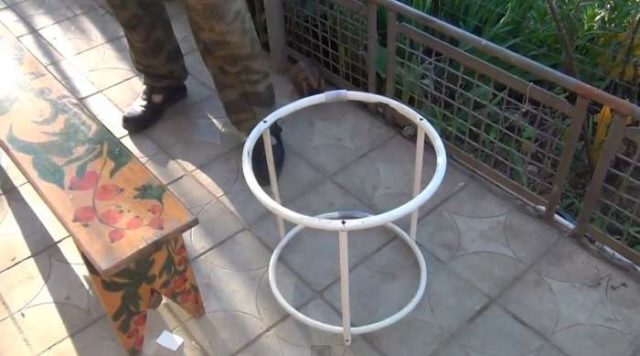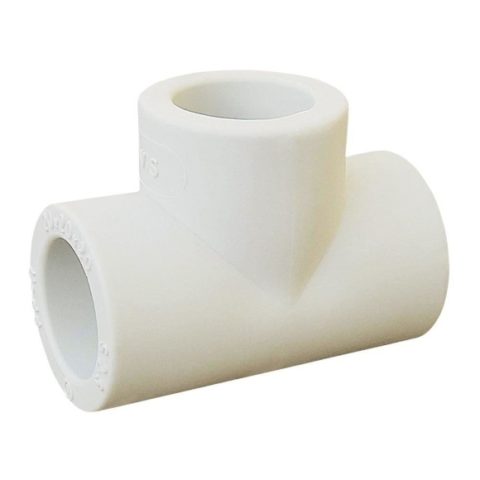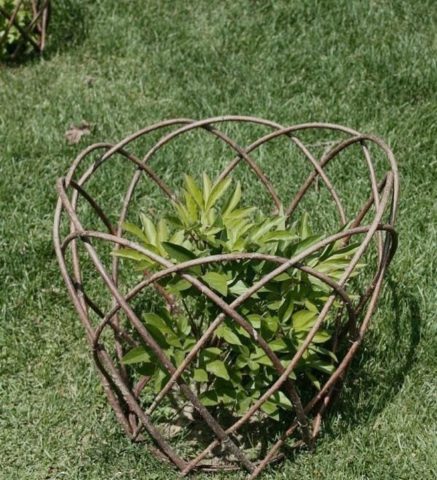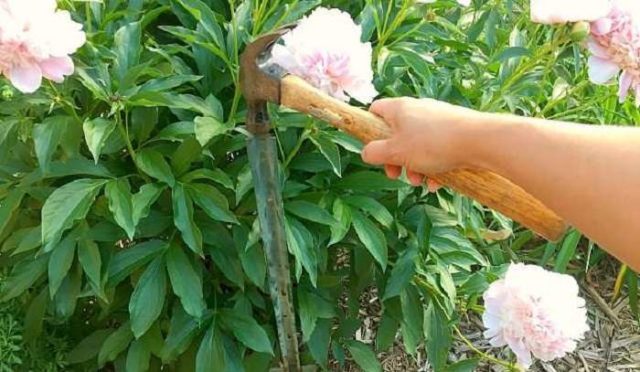Content
Lush flowers in a flowerbed need beautiful framing and support. Support for peonies is also necessary for practical purposes: even with a slight wind, the stems of the plant bend to the ground, large buds crumble. You can make a beautiful frame with your own hands without spending a lot of time and money on it.
The need to install supports for peonies
During the budding period, peony stems may break off under the weight of the inflorescences. After the rain, the bush falls apart and looks sloppy. To preserve its natural shape, prevent stems from breaking, and show all the beauty of a flowering plant, support is necessary. You can make it beautifully, in the form of a flowerpot or an ornate hedge, this will only decorate the flowerbed.
How to make a stand for peonies with your own hands
You can make supports for peonies with your own hands using photo instructions. To do this, you will need construction tools, fittings, plastic pipes, and all kinds of fasteners.
Stand No. 1 for peonies made of plastic pipes
The product is easy to make at home. To do this you will need tools and supplies.

The design is easy to use, putting it on a bush with peonies
What is needed to make a support:
- metal-plastic water pipe with a diameter of 20 or 26 inches (approximately 5-6 m);
- wood scraps;
- plastic barrel (its diameter must correspond to the size of the future support);
- screwdriver;
- dacha reinforced irrigation hose (its diameter should be slightly larger than the diameter of metal-plastic), the hose should be put on tightly;
- self-tapping screws
Materials for support are prepared in advance so that everything is at hand.
Algorithm of actions:
- The metal-plastic pipe is laid out along its entire length on a flat surface.
- A metal barrel is rolled over it so as to wrap the plastic around the container. This material is flexible, bends well and takes on rounded shapes.
The first curl is wound onto the barrel, then the plastic is rolled up in the same way along the entire length
- The process should result in a spiral-shaped workpiece.
Each subsequent curl should lie next to the previous one, and not overlap with it
- The resulting spiral is cut only in one place. The result will be 3 circles.
- The ends at the cut site are connected with a piece of irrigation hose (length 10-15 cm).
The length of the hose can be increased, thereby varying the diameter of the circle
- The plastic blank is divided into 3 equal sectors and marks are placed.
- For further work on making the support, you will need 2 such circles. On one of them, self-tapping screws are screwed into the marked places.
- From the same pipe you need to cut 3 columns 40 cm long.
- A wooden chop is driven into one end of the columns.
A wooden insert will allow you to connect the stand to the circle by screwing a screw into them
- The posts are connected to the circle with screws.To do this, drive a self-tapping screw through the plastic circle, in the places where there are marks, and screw it into the rack where there is a wooden chip.
- The lower ring is directly attached to the posts with screws.
Before using a homemade support for peonies, the plant is first tied up. The stand is then placed on top, passing the stems through the bottom circle. It is important not to damage the buds in the process.

The plastic support is lightweight, easy to install and dismantle, and is not susceptible to precipitation
Stand No. 2 for peonies made of plastic pipes
It’s even easier to make a prefabricated support for peonies from plastic pipes. To make it you will need special tees for PVC pipes.

Such a device will serve as fastening of structural elements
Required materials and tools:
- plastic pipe;
- 3-4 tees of suitable diameter;
- scissors for metal-plastic or hacksaw.
- roulette.
Pipes are taken in such a quantity as to cut a circle from it for support and rack.
Algorithm of actions:
- A segment equal to the circumference of the future support is cut off from the pipe.
- As in the first option, you can twist the plastic using a barrel.
- 3 or 4 tees are put on the resulting circle, one of them should connect the edges.
- Then 0.5 or 0.6 m long racks are cut from the consumable material. Their number is equal to the number of tees.
- The resulting supports are inserted into the tees at one end, and the other end is left free.
- A plastic stand is placed on the overgrown peony, and the stands are deepened into the ground.

This is a simple version of a support for bush peonies; you can assemble it like a construction set
Do-it-yourself stand No. 3 for peonies made from rebar
This type of fencing is suitable for those flower growers who do not accept stands for peonies made of plastic pipes in their flower beds, as they do not look completely natural. Eco-style flower beds require other materials.
To make a support you will need 5-6 rods of reinforcement; you can take any diameter, the length depends on the height of the bush. The work of making a fence is simple: the rods are bent in the shape of a semicircle, and the free ends are fixed in the ground, forming a fence.

A simple solution when the support looks openwork and decorative, but is only suitable for low bushes
For taller plants, it is better to make a large-scale product. Thin reinforcement lends itself well to influence and is easy to bend.

If you have a special tool, you can assemble a comfortable, thin support from reinforcement that does not hide the beauty of the plant
The structure is made in accordance with the height and volume of the bush. To assemble such a support, you will need a welding machine; it will help fasten the parts of the product.
How to tie peonies beautifully
For these purposes, simple designs are used that are easy to make with your own hands. There is an old, proven way to beautifully tie peonies; using a photo it’s easy to make a similar hedge.
The old way
Bush peonies have been tied up in this way for a long time. Such a fence does not look pretentious, simple and natural.
Tools, materials:
- roulette;
- wooden pegs;
- hammer;
- leg-split.
The pegs are cut to a height corresponding to the length of the peony stems, and the buds should be on top of the structure. It should also be taken into account that the wooden supports will be buried 10-15 cm into the ground.
Algorithm of actions:
- Pegs are driven in around the bush on 4 sides.
It is important to fix the supports at the same distance from each other and from the plant
- Notches are made on the pegs along the entire length so that the twine does not move out when winding.
- They take a rope, tie it tightly to one peg and begin to wrap it around other posts in a circle.
- The twine is fixed in several places by tying it with a strong knot to a peg.
The hedge does not need to be made too dense, as the greenery of the plant will not be visible.
Using a grid
The garden net holds the shape of the bush well and looks presentable. Experienced flower growers recommend tying peonies with a green net, as in the photo:

The support does not compete with the bright greenery of the bush, merges with it, looks organic
A layer 0.4 or 0.5 m long is cut from such material. A net is simply encircled around the bush, the edges are secured with thin wire.
There is another more labor-intensive method. To implement this, you will need a mesh with a large cell (5x10 cm). It is placed on germinating peonies and secured with pegs on each side. As they grow, the stems of the bush will stretch upward, occupying the cells of the cover. Once every 3 weeks, the net is raised higher so that the flowers can grow freely. There is no need to attach a relief support: it is supported by the foliage and does not allow the stems to bend.
Conclusion
The support for peonies should be light, mobile, and fit into the landscape of the garden or flower bed. Finished forged products are not cheap, they are heavy, and it is difficult to move them from place to place. You don’t have to buy expensive stands for peonies; you can simply make them yourself, as shown in the photo above.













